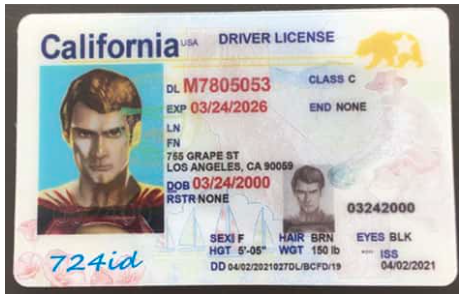
1. Demand-Driven
The demand for fake IDs often stems from dissatisfaction with legal restrictions or a desire for certain privileges. For instance, young adults seeking to legally purchase alcohol or gain entry into restricted venues such as nightclubs often turn to like California fake ID as a means of bypassing age restrictions. This demand highlights a strong pursuit of personal freedom and autonomy, driven by social and cultural pressures.
Underage Alcohol Consumption in the U.S: In the United States, individuals under 21 are legally prohibited from purchasing alcohol. To circumvent this restriction, many underage individuals use fake IDs to enter bars or buy alcoholic beverages. This demand for fake IDs is significant enough that it drives a thriving underground market. Companies like IDPAPA and IDLORD have been known to produce high-quality fake IDs, catering to this demand by offering products that closely mimic legitimate identification cards. These manufacturers often advertise their services on hidden forums or dark web marketplaces, demonstrating the widespread nature of the problem and the lengths to which people will go to sidestep legal limitations.
2. Market Feedback
The existence of the fake ID industry has driven policymakers and regulatory bodies to reconsider and adjust laws and regulations. In response to the challenges posed by fake IDs, many countries and regions have enhanced their identity verification systems and improved anti-counterfeiting technologies. This market feedback has prompted advancements in both policy and technology to better address and mitigate the issue of fake identification.
United Kingdom’s Enhanced Security Measures (2018): In 2018, the UK government implemented stronger anti-counterfeiting measures for identification cards and driver’s licenses. This included the incorporation of electronic chips and additional security features such as holograms and UV-reactive elements. These improvements were a direct response to the growing market for Utah scannable ID and the increasing need for more robust identity verification methods. The enhancements aimed to reduce the effectiveness of counterfeit IDs and strengthen overall security in the identification process.
3. Technological Advancements
The fake ID industry has driven significant advancements in anti-counterfeiting technology. To combat the proliferation of fake IDs, legitimate institutions and government agencies have invested heavily in sophisticated security measures. These technologies include high-resolution printing, laser engraving, watermarks, and electronic verification systems. These advancements not only help in countering fake IDs but also enhance security in other areas such as passports, credit cards, and official documents.
Alabama scannable ID: In recent years, Alabama introduced digital driver’s licenses with embedded chips and advanced security features. These chips store complex personal data and employ encryption techniques to prevent counterfeiting. For instance, Alabama’s digital driver’s license includes features such as dynamic barcodes and secure authentication methods to verify the ID’s authenticity in real-time. This technological upgrade was a direct response to the challenges posed by fake ID production, aiming to provide a more secure and tamper-resistant form of identification.
Enhanced Passport Security Features: Many countries, including the U.S. and EU nations, have upgraded their passport systems to include biometric data and embedded RFID chips. These passports use high-resolution printing and holographic overlays to deter counterfeiting. For example, the U.S. passport includes a digital chip that contains biometric data, such as fingerprints and facial recognition information, which are difficult to replicate and verify against official databases. These enhancements reflect the broader application of anti-counterfeiting technologies inspired by the need to combat fake IDs.
4. Economic Factors
Although the fake ID industry is illegal, it can provide economic opportunities for individuals or groups involved in these activities. These opportunities include income from producing fake IDs and associated illegal economic activities. This phenomenon often reflects a reliance on unconventional economic activities by some groups, particularly those facing economic hardship or limited legitimate employment options.
U.S. Fake ID like Ohio fake ID Manufacturer Arrest (2017): In 2017, a fake ID manufacturer in the United States was arrested for operating an illegal business. The individual was involved in producing high-quality fake IDs and reportedly earned hundreds of thousands of dollars from these activities. This case highlights how the illegal sale of fake IDs can become a significant source of income for those involved. The manufacturer’s operation not only impacted law enforcement efforts but also underscored how individuals can generate substantial revenue through illicit means.
Economic Impact in Drug Trafficking: In some instances, New York fake ID production is tied to broader illegal enterprises such as drug trafficking. For example, certain criminal organizations use fake IDs as part of their operations, including money laundering and smuggling. These activities provide financial gains for those involved and demonstrate how fake ID production can be part of a larger illegal economic ecosystem. The involvement in such activities often reflects the economic challenges faced by individuals who turn to these illicit means for financial stability.
The demand for fake IDs stems from challenges to existing legal restrictions. Particularly in areas involving age limitations and access to restricted venues, fake IDs offer a means to circumvent these laws. This demand reflects societal attitudes towards these restrictions and individuals’ pursuit of personal freedom. The fake ID industry has driven advancements in anti-counterfeiting technology. To combat forgery, legitimate institutions have adopted high-resolution printing, embedded chips, and complex security features. These technologies are not only used to combat fake IDs but are also widely applied in passports, credit cards, and other identification documents. In summary, the fake ID industry represents a challenge to existing laws and technology systems while driving innovation and policy adjustments in related fields. Understanding the complexity of this phenomenon helps in addressing and resolving issues associated with fake IDs.
